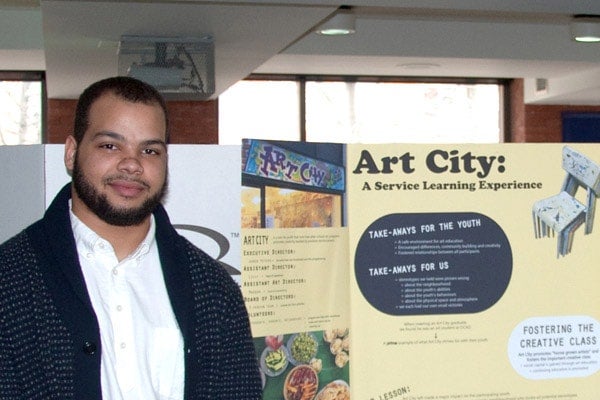
Urban studies students make an impact in the community
Published: March 31, 2015
While teaching youngsters to create papier mâché figures, Samson Okungbowa learned his own valuable lesson during a recent service learning placement at Art City in Toronto’s St. Jamestown neighbourhood: he discovered the value of experiencing neighbourhoods firsthand.
“There’s a stigma built up around St. Jamestown, but when you come to check it out, the social capital outweighs everything else,” Okungbowa said. “It’s all about breaking the stereotypes.”
Okungbowa is one of 54 second-year Introduction to Urban Studies students who chose the option of a service learning placement with a community organization over the alternative, a research paper. About two-thirds of the class fanned out to spend 12 hours apiece assisting programs such as Art City, Out of the Cold and the TD Centre of Learning in Regent Park. Afterward, they were each required to reflect on their experiences in a journal.
“Service learning helps students both reinforce the class content and learn more about issues such as urban inequality, civic engagement and gentrification,” said Shauna Brail, an urban studies professor and the director of experiential learning for the urban studies program.
“In a general sense, it also deepens their commitment to community engagement and strengthens their ability to be critical thinkers.”
Interested students in the full-year course have the choice of approximately a dozen organizations for placements. Brail works hard to match each student with one of his or her top choices. The students get information about the available placements in December and receive their assignments in January, the month they also attend an orientation session to meet representatives from the partner organizations and hear from students who have participated in previous years.
The students then head off to their placements in teams of two to five students that, said Brail, “allows students in a class of 80-plus to get to know each other better. It also gives them a real diversity of perspective, because they have one another to talk to and can learn from each other.”
The community organizations like Art City also reap benefits.
“We really rely on our volunteers to a certain extent,” said Jared Peters, the director of this free, multi-disciplinary art program for children, many of them newcomers to Canada. “They come and provide one-on-one attention for the kids. They may help them with homework and they help them to realize a specific vision for their artwork.”
“The four U of T students who joined us had a really great energy about them, and the kids really loved them.”
Okungbowa said he can already see lasting benefits from the experience.
“Just my openness to meeting new people has changed,” Okungbowa said. “Everyone has a story that is unique and important. There are a lot of connections to be made; why not go out and make them?”
“In lectures” he added, “I can connect things we’re discussing to Art City; I have real life connections to the material now.”
Brail is always delighted when the placements have the desired effect.
“Most research shows that the students who experience service learning show greater tolerance and understanding afterward,” Brail said. “It’s amazing to watch them grow through it and make connections.”
For his part, Okungbowa is ready for more.
“If I could do service learning every year as part of a course, I’d do it,” he said. “It’s so much fun, and it reignited my interest in the coursework.”



